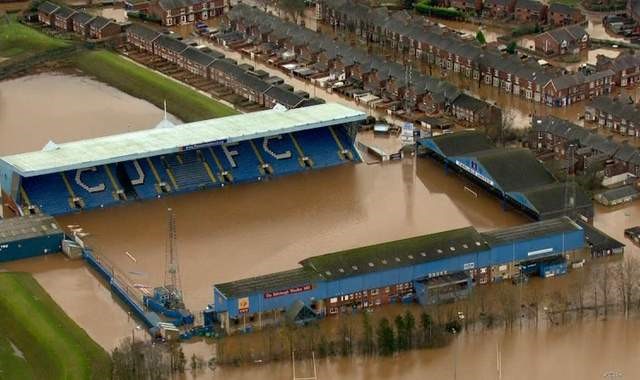Flood Risks at Football Stadiums
Waterlogged pitches have become a regular occurrence and expectation within the grassroots football season. So much so that in 2014 “the average [English] grassroots pitch lost 5 weeks per season to bad weather”. However, concerning forecasts have been made with regard to football stadiums flooding. This blog focuses on English football specifically but worries transcend beyond England and are global!
Current state of waterlogging
Beyond grassroots football, it has become quite regular that the occasional English Football League (EFL) match, especially in the lower divisions, are postponed due to waterlogged pitches. This has often occurred following major storms. For example, Storm Jorge in 2020 waterlogged and consequently postponed 5 matches across League One, League Two, and National League. We have also seen extreme flooding of football stadiums, such as during Storm Desmond in 2015 which is the biggest English flood in over half a millennium. It caused a number of football match postponements, with Carlisle United’s stadium, Brunton Park, completely submerged by floodwater. The flood put the stadium out of use for football for over 1½ months.

Climate change threatening English football
There are more threats to English football coming our way, raising major concerns! Predictions in 2050 suggest that “partial or total annual flooding” will come to 25% of English Premier League (EPL) and English Football League (EFL) stadiums. These frightening estimations come with the likelihood of sea level rise, leaving stadiums based near the coast, such as Southampton Football Club’s St Mary’s Stadium at high risk. Cardiff City’s Cardiff City stadium and Hull City’s MKM stadium are forecast to be completely submerged in 2050, a pretty scary thought!
The projected increase of longer periods of extreme rainfall coming with climate change will also have a great impact. London clubs in close proximity to the River Thames will be at risk of flooding. As the base level of sea levels being higher, a storm event could increase the risk of the Thames overtopping. Beyond London, we might subsequently see a rise in fixture postponements during the football season for clubs with vulnerable stadiums that are already susceptible to flooding as well as new stadiums at risk. This is a major problem that endangers football, and predictions are only a quarter of a century away!